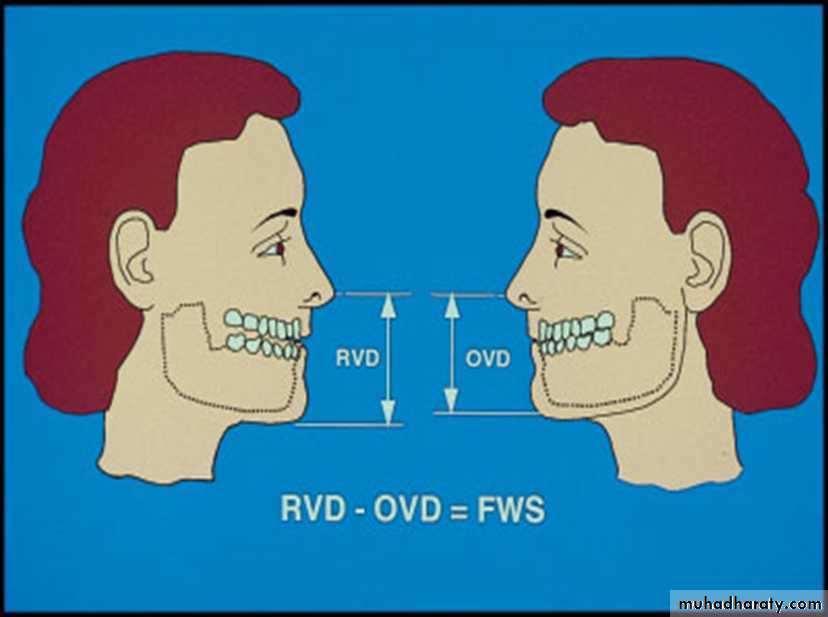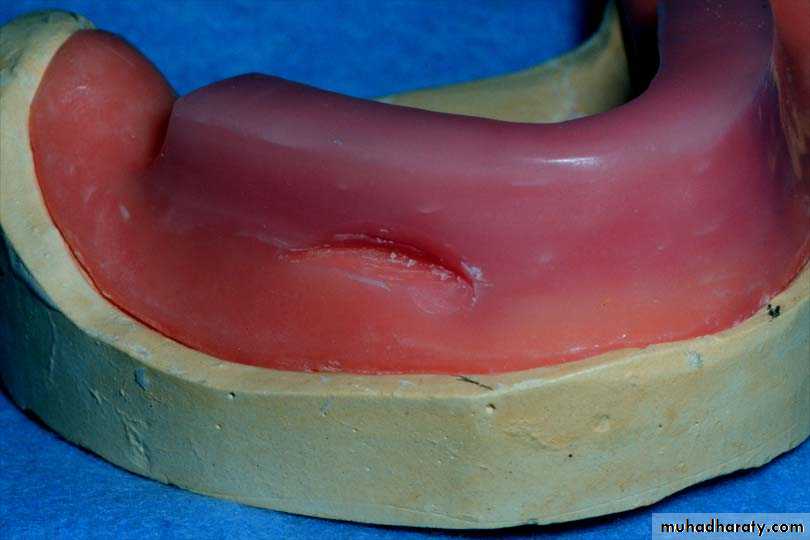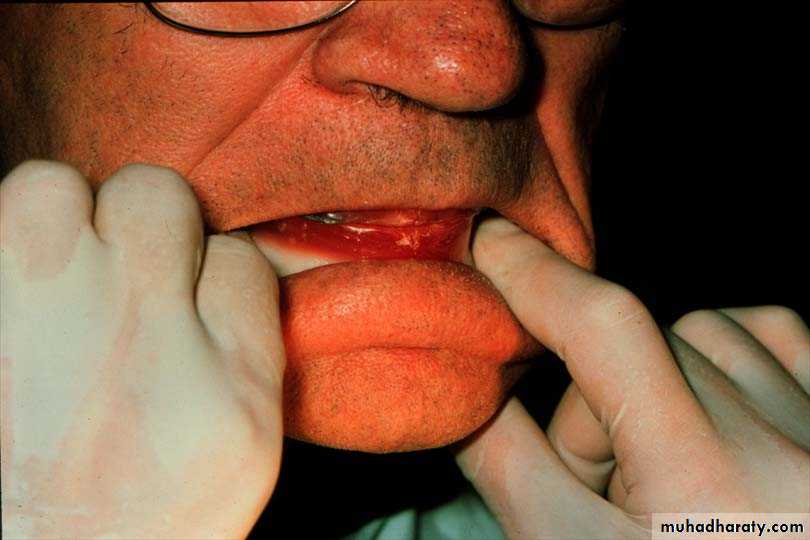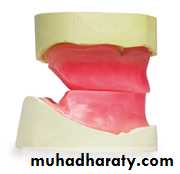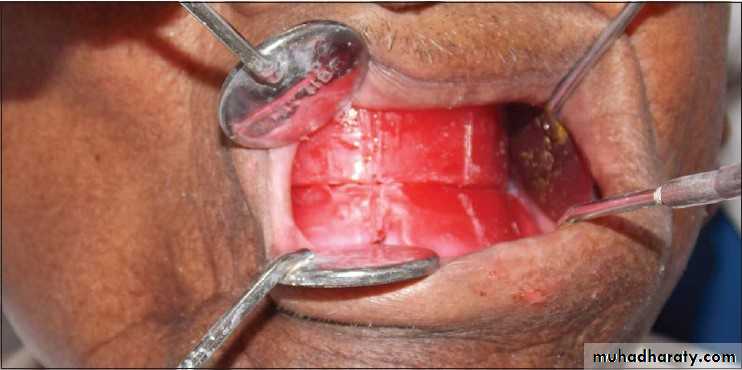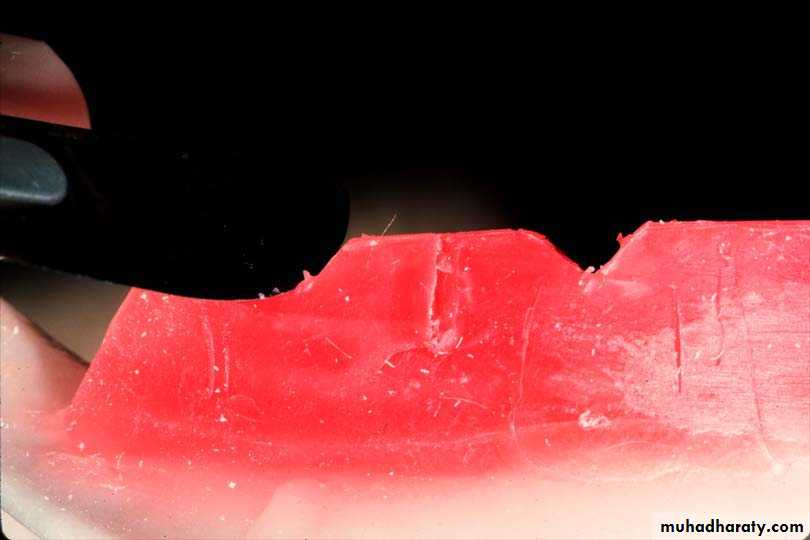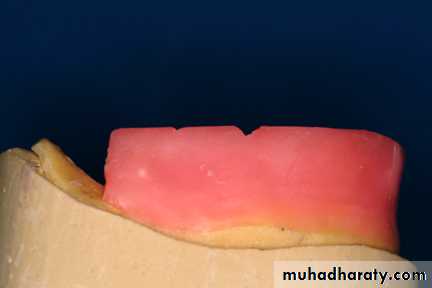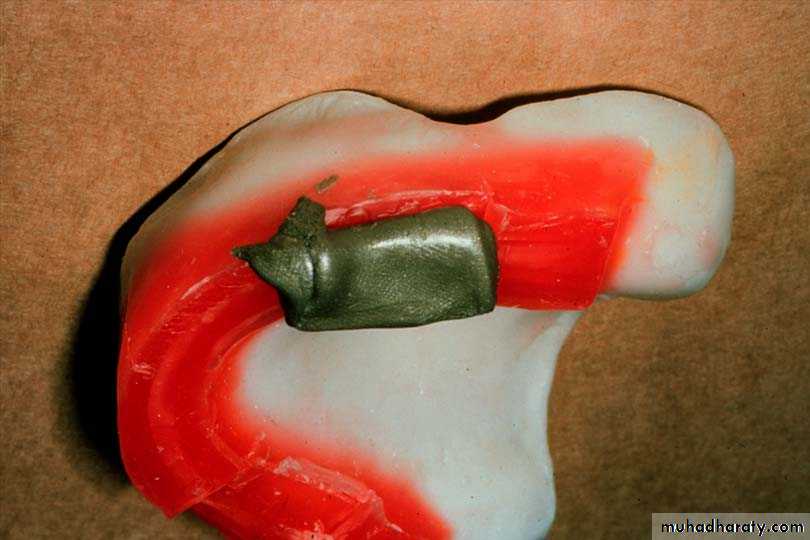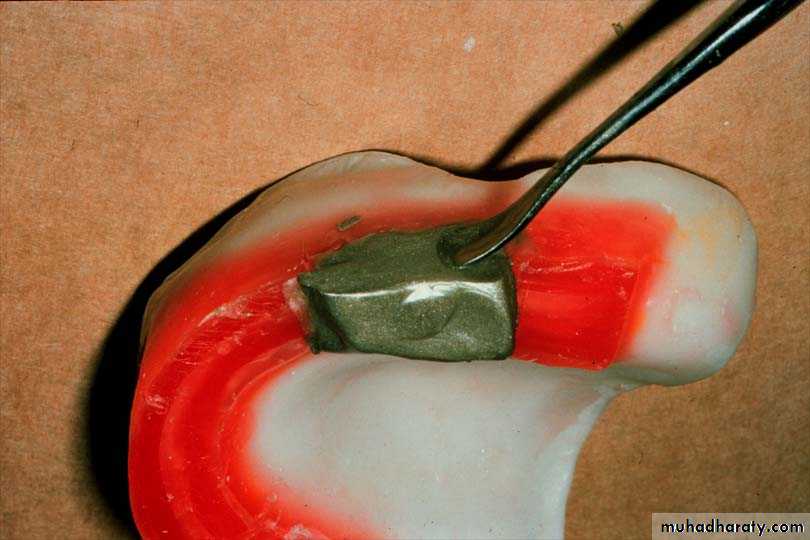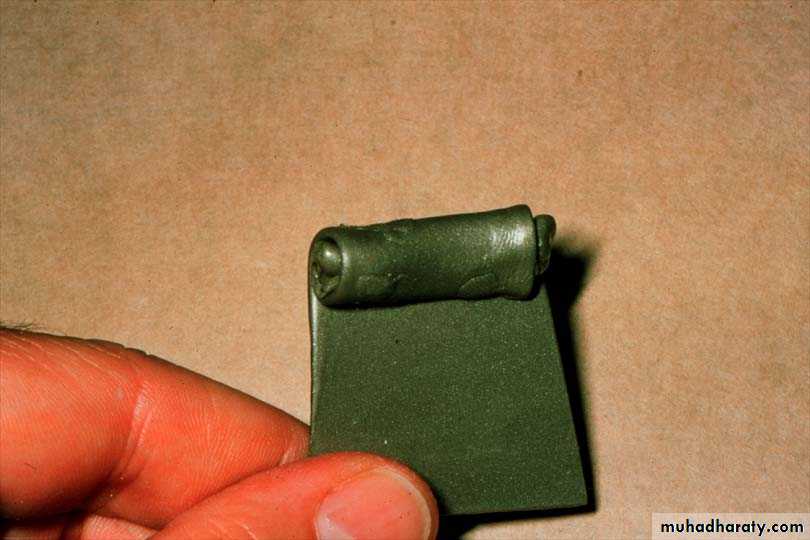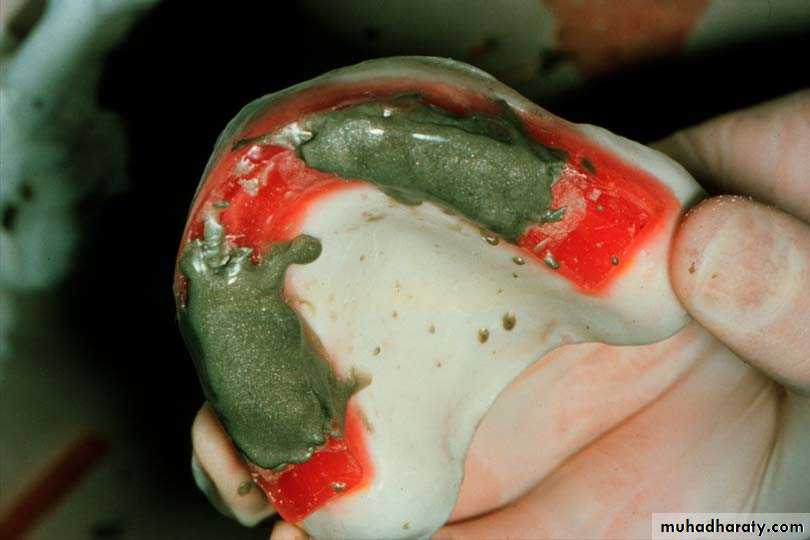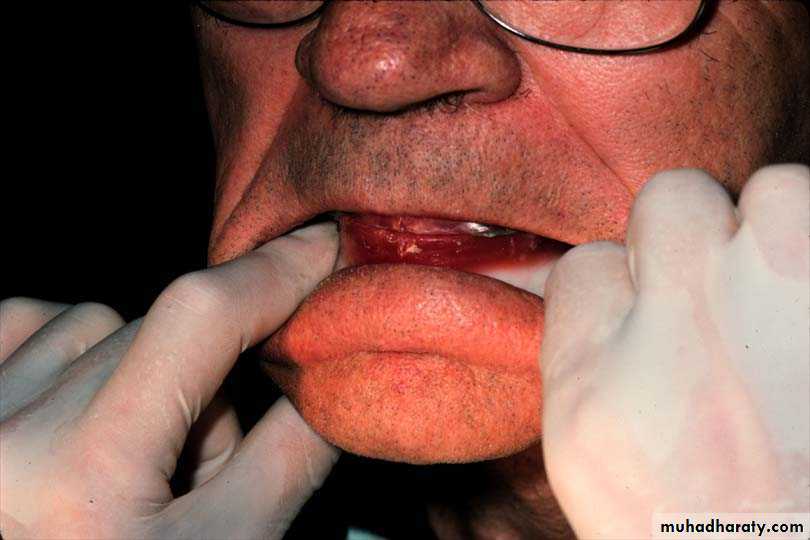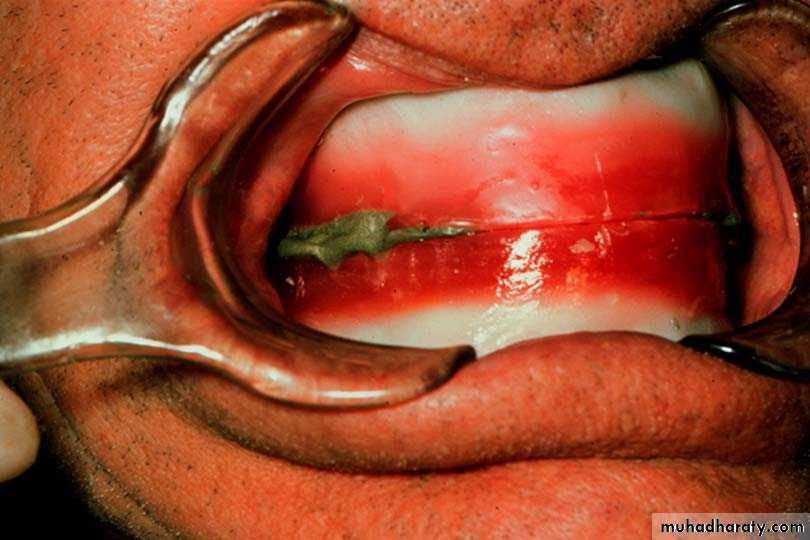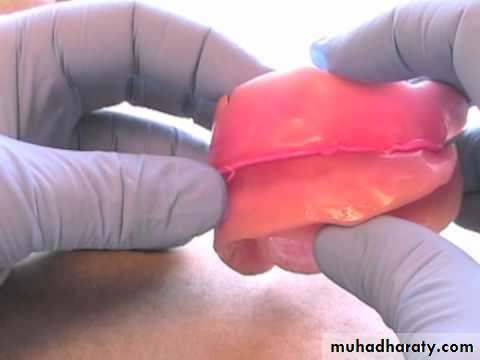Maxillo Mandibular Jaw Relation RecordsDr. Salah Kh. Al-RawiBDS, MSc. PhD Dental Science, Prosthodontist, Maxillo-Facial Prostheses
Orientation of Occlusal Plane
The occlusal plane is defined as the average plane established by the incisal and occlusal surfaces of the teeth".Fox bite or Fox plane
Importance of orientation of occlusal plane
Anteriorly, occlusal plane mainly helps in achieving esthetic & phonetic.
posteriorly, it forms a milling surface, where tongue & buccinator muscle are able to position the food bolus onto it , and hold it there during mastication.
Incorrect of occlusal plane would hamper esthetics, phonetics, & mastication. It may affect stability of complete denture & ultimately result in alveolar bone resorption.
The vertical length of the maxillary occlusion rim
Anteriorly extend 2mm below relaxed lip & oriented to be parallel to inter pupillary line.Posteriorly the vertical length and occlusal plane are made to be coincide with (Camper's line).
(Camper's line, ala-tragus line) line passing from the lowest point of the ala of the nose to the center of the tragus of the ear.
The vertical length of the mandibular occlusion rim
Anteriorly the level of mandibular occlusion rim with the level of the lower lip.Posteriorly the vertical length of the rim with level of the retromolar pad.
In case of failure in orientation of correct occlusal plane, that can be discovered clinically in the try-in step of complete denture construction, we should correct the defect by the following;
If the defect occur in posterior teeth
• Remove all posterior teeth (premolars &molars, upper & lower ).
• Re-orient the occlusal plane.
• Take vertical & horizontal relation.
• Re-mount the casts & re-arrange the teeth.
• Remove all anterior teeth.
• Re-arrange the teeth.
Vertical Relations
Vertical Relations
Rest vertical dimension The distance between two selected points one on the fixed part (maxillae) and one on the movable part (mandible) when the maxillofacial musculature is in a state of tonic equilibrium.
Occlusal vertical dimension : the distance between two selected points one on the fixed part (maxillae) and one on the movable part (mandible) when occluding members (teeth) are in contact.
Recording the Rest Vertical Dimension (physiological methods)
Facial measurements (reference points)Tactile sense (opening ------- closing)
Phonetics (em)
Facial expression (skin tone and the lips contour)
Anatomic land marks (Willis guide)
Recording the occlusal vertical dimension (mechanical methods):
• Pre-extraction records• Profile photographs
• Radiography (cephalometric profile and the condyles in the fossae)
• Articulated cast
• Facial measurements
• Former dentures
• Edentulous patients (wax occlusion rims)
Evaluating vertical dimension
The inter occlusal distance (free way space) is the distance or gap existing between the upper and the lower teeth when the mandible is in the physiological rest position. It is usually 2-4 mm when observed at the position of the first premolars.
The closest speaking space is the closest relationship of the occlusal surfaces and incisal edges of the mandibular teeth to the maxillary teeth during function and rapid speech.
Patients tactile sense
Swallowing followed by relaxing (cones of a soft wax )Phonetics (3, 33) (5,55) ( Emma )
Horizontal Relations
Compensating Curve [ Glossary of Prosthodontics Terms]Is the “antero-posterior curvature (in the median [sagittal] plane) (Curve of Spee in the natural dentition). And the medio-lateral curvature (in the frontal plane) Curve of Wilson in the natural dentition.
“The curve introduced in the construction of complete dentures to compensate for opening influences produced by the condylar and incisal guidances during lateral and protrusive mandibular movements-called also the compensating curvature, compensating curve”.
•
Each Condyle Moves About 3 Axes
Vertical
SagittalHorizontal
Movements of the MandibleHinge like movement used in opening & closing the mouth for introduction of food & crushing brittle food.
Protrusive movement used in the grasping & incision of food.
Right or left lateral movements use in the reduction of fibrous food.Bennett movement the bodily side shift of the mandible which when it occurs may be recorded in the region of the rotating condyle on the working side.
• The relation of the lower to the upper jaw when the condyles are in their most posterior and superior position in the mandibular (glenoid) fossae.
•
It is defined as any relation-ship of the mandible to the maxilla other than the centric relation. It includes protrusive and lateral relations. The main reason in making an eccentric jaw relation record is to adjust the horizontal and lateral condylar inclination in the adjustable articulator, and to establish the balanced occlusion.
Eccentric Jaw Relation
METHODS USED TO MAKE CENTRIC RELATION RECORD
1- Functional (chew in)The Needles – House technique and the Patterson technique are examples of the functional method. Both are based on same principle. The patient produces a pattern of mandibular movements by moving the mandible to protrusion, retrusion, and right and left lateral.
A- Needles – House technique uses compound occlusion rims with four metal styli placed in the maxillary rim. When the mandible moves with the styli contacting the mandibular rim, the styli cut four diamond shaped tracings. The tracings incorporate the movements in three planes, and the records are placed on a suitable articulator.
B- Patterson Method uses wax occlusion rims. A trench is made along the length of mandibular rim. A 1:1 mixture of pumice and dental plaster is loaded into the trench. When the patient moves his mandible, compensating curves on the mixture will produced, and the height of the mixture is also reduced. The patient is asked to continue these movements till a predetermined vertical dimension is obtained. Finally, the patient is asked to retruded his jaw and the occlusal rims are fixed in this position with metal staples.
2- Graphic Method
These methods are called so because they use graphs or tracing to record the centric relation. The general concept of this technique is that a pen-like pointer is attached to one occlusal rim and a recording plate is placed on the other rim, the plate coated with carbon or wax on which the needle point can make the tracing, when the mandible moves in horizontal plane, the pointer draws characteristic patterns on the recording plate.The characteristic patterns created on the recording plate is called arrow point tracing, also known as Gothic arch tracing. The apex of the arrow point tracing gives the centric relation, with the two sides of the tracing originating at that point being the limits of the lateral movements. The apex of the arrow head should be sharp else the tracing is incorrect.
The graphic methods are either intraoral or extraoraldepending upon the placement of the recording device. The extraoral is preferable to the intraoral tracing, because the extraoral is more accurate, more visible, and larger in comparing with the intraoral tracing.
3- TACTILE OR INTER OCCLUSAL CHECK RECORD
The tactile or inter occlusal check record method is referred to as a physiologic method. The normal functioning of the patients and the tactile sense is essential in the making of an accurate record.The records are made using a recording medium (impression plaster, zinc oxide eugenol, impression compound and wax) between the occlusion rims or the trial denture bases. The patient closes into the recording medium with the lower jaw in its most retruded position and stops the closure at a predetermined vertical relation.
Establishing Maxillomandibular Relationships
Equipment for establishingmaxillomandibular relationships include:
• Baseplate wax
• Busen burner• Indelible pencil or marking stick
• Laboratory knife
• Mandibular cast with wax occlusion rim
• Maxillary cast with record base
• Occlusal plane indicator
• Ruler
• Sticky wax
• Wax spatula
• Rim former
Paralleling the Wax Rim to the Occlusal Plane
A useful definition of the occlusal plane is “the surface that is parallel both to the ala-tragal plane (Camper’s Plane) and to the interpupillary line.“
Adjusting the Occlusion Rim
Determining the Rest Vertical Dimension (RVD
1
2
3
4
Occlusion rim notched to aid stabilizing the record bases
•
• Index fingers on the rim, thumbs under chin• Place 3 widely separated lines between the rims in the centric position (mid line & canine eminences).
Check that record base heels (rims do not touch).
Two sharp “V”-shaped notches in the molar/premolar area of each sided wax depth 1-2 mm.
Ensure adequate notch depth.
Too Shallow
1-2 mmPlace Aluwax into a 1-2mm slot in maxillary rim.
Fill to slight excess.Ensure wax is dead soft.























